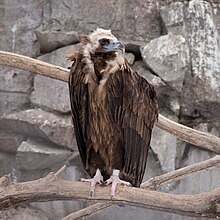| Aegypius | |
|---|---|

| |
| Cinereous vulture, (Aegypius monachus) | |
| Conservation status | |
 Near Threatened (IUCN 3.1) | |
| Scientific classification | |
| Domain: | Eukaryota |
| Kingdom: | Animalia |
| Phylum: | Chordata |
| Class: | Aves |
| Order: | Accipitriformes |
| Family: | Accipitridae |
| Subfamily: | Aegypiinae |
| Genus: | Aegypius Savigny, 1809 |
| Species | |
Aegypius is a genus of Old World vultures found in the subfamily Aegypiinae. Of the three species in the genus, only the cinereous vulture is extant. The cinereous vulture (Aegypius monachus) is a creature that is hard to find as it is “a near threatened raptor that occurs in isolated populations across its range” (Çakmak). There were studies being conducted on the cinereous vulture and it indicates “that the Turkish birds hold, along with those from the Caucasus, an intermediate position between European (Balkan and Iberian) and North Asian (Mongolian) lineages” (Çakmak). The genus name Aegypius is a Greek word (αἰγυπιός) for 'vulture', or a bird not unlike one; Aelian describes the aegypius as "halfway between a vulture (gyps) and an eagle". Some authorities think this a good description of a lammergeier; others do not. Aegypius is the eponym of the species, whatever it was.
The only extant species from this genus is the cinereous vulture or Aegypius monachus. This vulture is one of the largest birds of prey and it plays a huge role in its various ecosystems by eating carcasses, and which in turn reduces the spread of diseases. The vultures are constantly exposed to many pathogens because of their eating habits. A study on the gastric and immune defense systems done in 2015, sequenced the entire genome of the cinereous genome. Comparing the vulture and the bald eagle, will allow the study to find positively selected genetic variations associated with respiration and the ability of the vulture's immune defense responses and gastric acid secretion to digest carcasses.
References
- BirdLife International (2021). "Aegypius monachus". IUCN Red List of Threatened Species. 2021: e.T22695231A154915043. doi:10.2305/IUCN.UK.2021-3.RLTS.T22695231A154915043.en. Retrieved 18 November 2023.
- Celoria, Francis, ed. (1992). The Metamorphoses of Antoninus Liberalis : a translation with a commentary. London and New York: Routledge. p. 116 (note 60). ISBN 978-0-415-06896-3.
- ^ Chung, Oksung; Jin, Seondeok; Cho, Yun Sung; Lim, Jeongheui; Kim, Hyunho; Jho, Sungwoong; Kim, Hak-Min; Jun, Jehoon; Lee, Hyejin; Chon, Alvin; Ko, Junsu; Edwards, Jeremy; Weber, Jessica A.; Han, Kyudong; o'Brien, Stephen J.; Manica, Andrea; Bhak, Jong; Paek, Woon Kee (2015). "The first whole genome and transcriptome of the cinereous vulture reveals adaptation in the gastric and immune defense systems and possible convergent evolution between the Old and New World vultures". Genome Biology. 16: 215. doi:10.1186/s13059-015-0780-4. PMC 4618389. PMID 26486310.
Further reading
- Genetic diversity is retained in a bottlenecked Cinereous Vulture population in Turkey E Çakmak, Çİ Akin Pekşen, Cİİ Kİrazli, Eİ Yamaç, S Bensch, CC Bilgin Ibis 161 (4), 793-805 6 2019
- Extremely low mitochondrial DNA diversity in a near threatened species, the Cinereous Vulture Aegypius monachus in Turkey E Çakmak, ÇA Pekçen, C Kirazlı, E Yamaç, CC Bilgin Ardea 107 (1), 85-92
| Genera of eagles, condors and their extinct allies | |||||||||||||||||
|---|---|---|---|---|---|---|---|---|---|---|---|---|---|---|---|---|---|
| |||||||||||||||||
| |||||||||||||||||
| Taxon identifiers | |
|---|---|
| Aegypius | |


